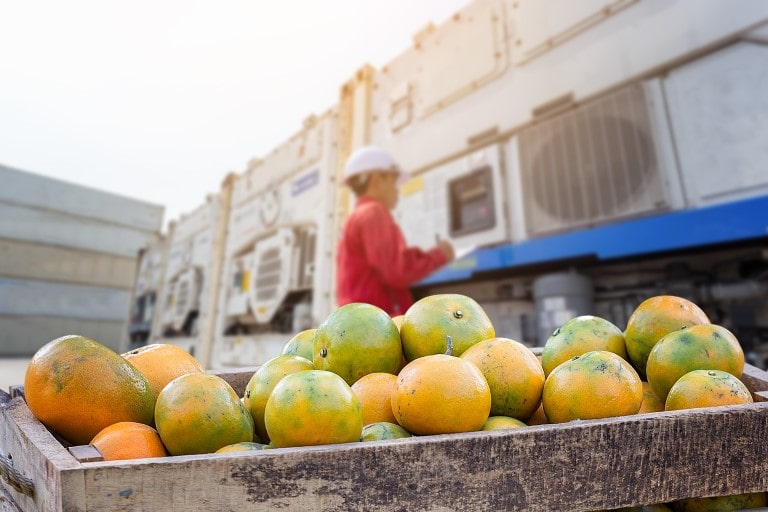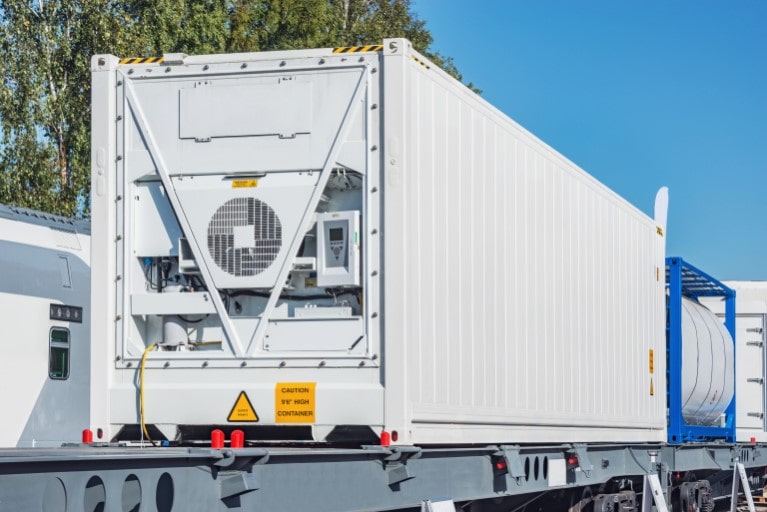Ever wonder how foods that easily spoil, like fruits, vegetables and dairy products, can reach you almost farm fresh from the opposite side of the globe? The simple answer is they are delivered in refrigerated shipping containers, which are also called reefer containers.
Unlike normal containers that can heat up or freeze according to the outside temperature, reefer containers come with an integral refrigeration and ventilation unit that controls the temperature inside the container. It’s not just the temperature that is critical for the items being transported by reefer containers, even the air needs to be circulated in the right proportions to make sure that the gases being released by the items themselves don’t spoil the cargo. For example, there are many fruits and vegetables that constantly release gases and moisture and if the ventilation is not efficient they will over-ripen and spoil.
Although a reefer container comes with its own mechanism to control the inside temperature, it needs outside power to run its functions. Therefore, how many reefer containers a ship or a train carries depends on how much power it can provide to the units being transported.
Interesting fact: Did you know that bananas are the largest single commodity (20%) transported around the world in reefer containers?
But it isn’t just food items that are transported using reefer containers. Everything that is perishable, everything that can spoil due to variations in temperature and release of gases, anything that goes bad when it comes in contact with the surrounding atmosphere, can be preserved using reefer containers.
Check out our top 10 list of items typically transported by reefer containers
1. Transporting fruits and vegetables

This is the most common use of reefer containers. Fruits and vegetables are generally transported by sea and road and in cases of emergency, also by air. Referring back to the example of bananas, the largest reefer container ship can accommodate 15,000 boxes of bananas that roughly comes to 746 million bananas, almost the population of Europe.
2. Transporting dairy products
Compared to bananas, dairy products don’t have a very big market in terms of reefer container usage because the movement is normally either within the country or within the continent (unless the dairy products are solidified or pasteurised). Most reefer containers are hoisted onto trucks and trains to transport dairy products to different places.
3. Transporting meat and poultry
After fruits and vegetables, meat and poultry are the next largest consignment of items that are shipped by reefer containers across the oceans. According to this Economist article on emerging meat-eating trends, in the mid-50s the global consumption of meat was 70 million tonnes and by 2007 the demand had increased to over 260 million tonnes.This is primarily because many regions where meat and poultry weren’t consumed came on the market.
4. Transporting seafood

The shipping of seafood warrants a separate category because 19% of the food items being shipped using reefer containers are seafood and seafood products. Seafood spoils easily, as anyone visiting a fish food market will testify. This is why reefer containers carrying seafood need to be of exceptional quality to ensure that it reaches kitchens possibly as fresh as it has just been taken out of water.
5. Transporting medicines
There was a time when long-distance distribution of medicines wasn’t possible because refrigeration and ventilation technologies weren’t as advanced as they are today. There was no alternative but to send the medicines by air. This didn’t just limit the amount of medicines that could be transported (aeroplanes are not as big as ships) it also increased the cost of these medicines enormously. Reefer containers these days allow transportation of huge amounts of medicinal cargoes. As a result, the cost of many medicines have been brought down and bulk medicines can be transported in one go.
6. Transporting and preserving movie set props
Yes, transporting movie props and other movie-related paraphernalia using reefer containers may seem like an overkill but when it comes to carrying around millions of dollars worth of production equipment, big movie producers often depend on reefer containers. Reefer containers are also used when shooting is done in harsh environments and the delicate equipment and props need to be saved from nature’s elements. In such cases, the installation and temperature control capabilities of reefer containers come in handy.
7. Transporting flowers

The next time you give someone a bouquet you may not be aware that you’re part of the $40 billion global fresh-cut flower market. The flowers that you have chosen might have come from South America, Europe, Australia or Asia with all the fragrance and tenderness intact as if they have just been plucked. This intercontinental, unprecedented freshness is ensured by reefer containers.
New reefer containers are being developed with an ozone concentration of 300 times higher than anything is available in the shipping industry that would stop bacteria, fungi and moulds from destroying the flowers. Around 700,000 metric tonnes of cut flowers are transported worldwide and although more than 90% travel by air, the advancement in reefer container refrigeration and ventilation is making it possible to send more and more varieties of flowers by sea. This tremendously increases the quantity of flowers that can be shipped and significantly reduces the cost of shipment.
8. Transporting and storing wine
The wine that we drink lives and breathes according to the atmosphere around it. It is not like your average alcoholic beverage. Just like any perishable product, wine can also go bad with sudden temperature changes and this is why when your bottle of wine travels across the oceans, it travels in highly specialised reefer containers. Just like the Phoenicians who sailed their long barges of wine around a couple of thousand years ago, many varieties of wine these days are transported by sea.
9. Being useful during military operations
Reefer containers are used by military forces across the world for the transportation and storage of food, medicine, chemicals and items that can perish in adverse climatic conditions. The reefer containers used by the military can withstand extreme temperatures, electromagnetic interference and vibration. They can be used for road, air as well as sea transportation due to their various sizes and dimensions.
10. Using reefer containers during disaster management

There are a variety of innovative ways shipping containers can be used during disaster management. The ability to control their interior temperature makes them ideal candidates for storing medicines and vaccines, food items, fruits and vegetables, during disaster management.
Wherever atmospheric conditions need to be controlled, whenever you want temperature and flow of air closely monitored and moderated, you can use reefer containers provided they can be transported and the quantity of the items being preserved justifies their usage. They can keep perishable goods such as eatables, beverages, emergency supplies and medicines from going bad during long sea journeys.
Why use refrigerated shipping containers instead of sending items by air?
An aeroplane, no matter how large it is, is quite small compared to even a standard sized ship. The quantity of consignments that can be sent by ship can be 100 times more than those sent by the biggest of cargo planes. This means an aeroplane would need to make hundreds of rounds to deliver goods that can be delivered by a ship in just one go. You can easily imagine the sort of impact it has on the final cost of the products being shipped.
Looking for high-quality affordable reefer containers for your next consignment?

Our 20 feet and 40 feet reefer containers are available for hire or for purchase at very competitive rates. All reefer containers from Gateway adhere to international safety standards and legislation and every refrigerated unit goes thorough inspection and stringent quality check prior to delivery. Our reefer containers can be used, aside from shipment purposes, for storing perishable goods, flowers, temporary cold storage during renovations and everything else that requires controlled temperature in order to stay in good condition. We can easily modify your reefer container according to your requirements. Contact our team now to find the perfect reefer container for your next consignment.




